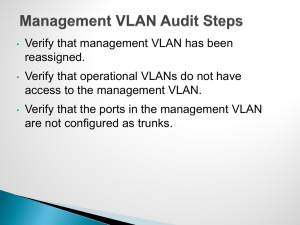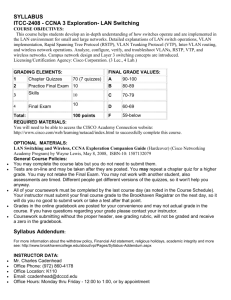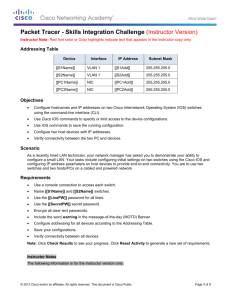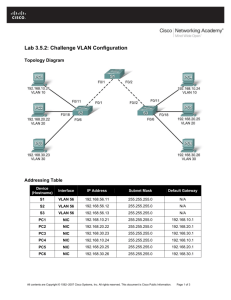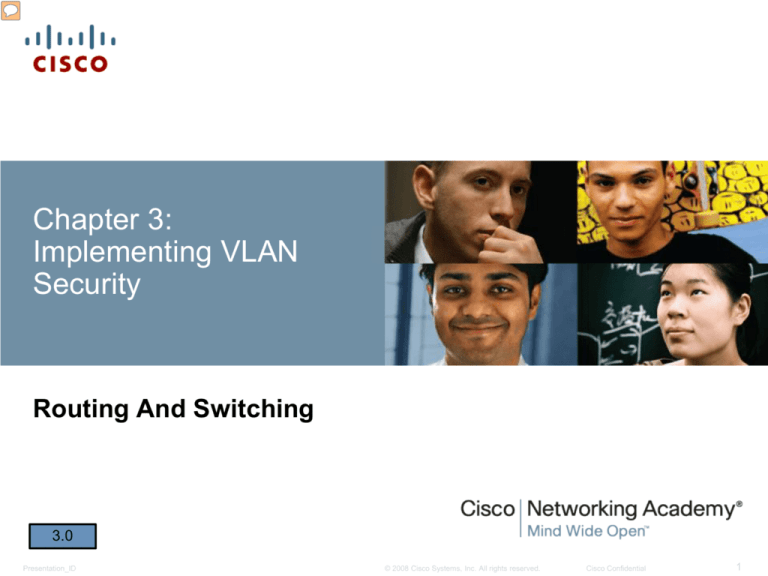
Chapter 3:
Implementing VLAN
Security
Routing And Switching
3.0
Presentation_ID
© 2008 Cisco Systems, Inc. All rights reserved.
Cisco Confidential
1
Chapter 3
3.1 VLAN Segmentation
3.2 VLAN Implementation
3.3 VLAN Security and Design
3.4 Summary
3.0
Presentation_ID
© 2008 Cisco Systems, Inc. All rights reserved.
Cisco Confidential
2
Chapter 3: Objectives
Explain the purpose of VLAN in a switched network
Analyze how a switch forwards frames based VLAN configuration in
a multi-switched environment
Configure a switch port to be assigned to a VLAN based on
requirements
Configure a trunk port on a LAN switch
Configure Dynamic Trunk Protocol (DTP)
Troubleshoot VLAN and trunk configurations in a switched network
Configure security features to mitigate attacks in a VLAN-segmented
environment
Explain security best practices for a VLAN-segmented environment
3.0.1.1
Presentation_ID
© 2008 Cisco Systems, Inc. All rights reserved.
Cisco Confidential
3
Overview Of VLANs
VLAN Definitions
VLAN (virtual LAN) is a logical partition of a layer 2
network
Multiple partition can be created, allowing for multiple
VLANs to co-exist
Each VLAN is a broadcast domain, usually with its own
IP network
VLANS are mutually isolated and packets can only
pass between them through a router
The partitioning of the layer 2 network takes inside a
layer 2 device, usually a switch.
The hosts grouped within a VLAN are unaware of the
VLAN’s existence
3.1.1.1
Presentation_ID
© 2008 Cisco Systems, Inc. All rights reserved.
Cisco Confidential
4
Overview Of VLANs
VLAN Definitions
3.1.1.1
Presentation_ID
© 2008 Cisco Systems, Inc. All rights reserved.
Cisco Confidential
5
Overview Of VLANs
Benefits of VLANs
Security
Cost reduction
Better performance
Shrink broadcast domains
Improved IT staff efficiency
Simpler project and application management
3.1.1.2
Presentation_ID
© 2008 Cisco Systems, Inc. All rights reserved.
Cisco Confidential
6
Overview Of VLANs
Types of VLANs
Data VLAN
Also know as User Vlan – user data traffic
Default VLAN
If no config on the switch all ports on on this vlan
(the default is vlan 1.)
Native VLAN
802.1Q trunk port
For ports that go between switches
Management VLAN
to access the management capabilities of a switch
3.1.1.3
Presentation_ID
Know details of each type of vlan from 3.1.1.3
© 2008 Cisco Systems, Inc. All rights reserved.
Cisco Confidential
7
Overview Of VLANs
Types of VLANs
3.1.1.3
Presentation_ID
show vlan brief
Know: switch virtual interface (SVI)
© 2008 Cisco Systems, Inc. All rights reserved.
Cisco Confidential
8
Overview Of VLANs
Voice VLANs
VoIP traffic is time-sensitive and requires:
•
•
•
•
Assured bandwidth to ensure voice quality
Transmission priority over other types of network traffic
Ability to be routed around congested areas on the network
Delay of less than 150 ms across the network
The voice VLAN feature enables access ports to carry
IP voice traffic from an IP phone
The switch can connect to a Cisco 7960 IP Phone and
carry IP voice traffic
Because the sound quality of an IP phone call can
deteriorate if the data is unevenly sent, the switch
supports quality of service (QoS)
3.1.1.4
Presentation_ID
© 2008 Cisco Systems, Inc. All rights reserved.
Cisco Confidential
9
Overview Of VLANs
Voice VLANs
The Cisco 7960 IP Phone contains an integrated threeport 10/100 switch:
• Port 1 connects to the switch
• Port 2 is an internal 10/100 interface that carries the IP phone
traffic
• Port 3 (access port) connects to a PC or other device.
3.1.1.4
Presentation_ID
© 2008 Cisco Systems, Inc. All rights reserved.
Cisco Confidential
10
Overview Of VLANs
Who Hears the Broadcast?
3.1.1.5 Packet
Tracer - Who Hears
the Broadcast?
• Do this in class
briefly. Show the
broadcasts are
limited to each
vlan:
• Have students do
this in class, but
not for a grade.
3.1.1.5
Presentation_ID
Show Packet Tracer 3.1.1.5 in class Delete
the VLANs and repeat the broadcast
© 2008 Cisco Systems, Inc. All rights reserved.
Cisco Confidential
11
VLANs in a Multi-Switched Environment
VLAN Trunks
A VLAN trunk carries more than one VLAN
Usually established between switches so same-VLAN
devices can communicate even if physically connected
to different switches
A VLAN trunk is not associated to any VLANs. Neither
is the trunk ports used to establish the trunk link
“A VLAN trunk does not belong to a specific VLAN; rather, it is a
conduit for multiple VLANs between switches and routers.”
Cisco IOS supports IEEE802.1q, a popular VLAN trunk
protocol
3.1.2.1
Presentation_ID
© 2008 Cisco Systems, Inc. All rights reserved.
Cisco Confidential
12
VLANs in a Multi-Switched Environment
VLAN Trunks
3.1.2.1
Presentation_ID
© 2008 Cisco Systems, Inc. All rights reserved.
Cisco Confidential
13
VLANs in a Multi-Switched Environment
Controlling Broadcast Domains with VLANs
VLANs can be used to limit the reach of broadcast
frames
A VLAN is a broadcast domain of its own
Therefore, a broadcast frame sent by a device in a
specific VLAN is forwarded within that VLAN only.
This help controlling the reach of broadcast frames and
their impact in the network
Unicast and multicast frames are forwarded within the
originating VLAN as well
3.1.2.2
Presentation_ID
Do buttons and animations on 3.1.2.2
© 2008 Cisco Systems, Inc. All rights reserved.
Cisco Confidential
14
VLANs in a Multi-Switched Environment
Tagging Ethernet Frames for VLAN Identification
Frame tagging is used to properly transmit multiple VLAN
frames through a trunk link
Switches will tag frames to identify the VLAN they belong.
Different tagging protocols exist, with IEEE 802.1q being a
very popular one
The protocol defines the structure of the tagging header
added to the frame
Switches will add VLAN tags to the frames before placing
them into trunk links and remove the tags before forwarding
frames through non-trunk ports
Once properly tagged, the frames can transverse any
number of switches via trunk links and still be forward within
the correct VLAN at the destination
3.1.2.3
Presentation_ID
© 2008 Cisco Systems, Inc. All rights reserved.
Cisco Confidential
15
VLANs in a Multi-Switched Environment
Tagging Ethernet Frames for VLAN Identification
Know:
IEEE 802.1Q
header
3.1.2.3
Presentation_ID
© 2008 Cisco Systems, Inc. All rights reserved.
Cisco Confidential
16
VLANs in a Multi-Switched Environment
Native VLANs and 802.1q Tagging
A frame that belongs to the native VLAN will not be
tagged
A frame that is received untagged will remain untagged
and placed in the native VLAN when forwarded
If there are not ports associated to the native VLAN and
no other trunk links, an untagged frame will be dropped
In Cisco switches, the native VLAN is VLAN 1 by
default
3.1.2.4
Presentation_ID
© 2008 Cisco Systems, Inc. All rights reserved.
Cisco Confidential
17
VLANs in a Multi-Switched Environment
Voice VLAN Tagging
The phone strips the VLAN tag before
the data is forwarded to PC5.
3.1.2.5
Presentation_ID
Do buttons on 3.1.2.5
© 2008 Cisco Systems, Inc. All rights reserved.
Cisco Confidential
18
VLANs in a Multi-Switched Environment
3.1.2.6 Activity - Predict Switch Behavior
3.1.2.6
Presentation_ID
Students do buttons on 3.1.2.6
© 2008 Cisco Systems, Inc. All rights reserved.
Cisco Confidential
19
VLANs in a Multi-Switched Environment
3.1.2.7 Packet Tracer - Investigating a VLAN Implementation
Show steps 1 – 3 in class
Steps 1 and 2 are with VLAN
Step 3 removes the vlans and reloads the switches
then does the arp request again
3.1.2.7
Presentation_ID
© 2008 Cisco Systems, Inc. All rights reserved.
Cisco Confidential
20
VLAN Assignment
VLAN Ranges On Catalyst Switches
The Catalyst 2960 and 3560 Series switches support
over 4,000 VLANs (2^12 = 4096)
These VLANs are split into 2 categories:
Normal Range VLANs
• VLAN numbers from 1 through 1005
• Configurations stored in the vlan.dat (in the flash)
• VTP can only learn and store normal range VLANs
Extended Range VLANs
• VLAN numbers from 1006 through 4096
• Configurations stored in the running-config (in the NVRAM)
• VTP does not learn extended range VLANs
3.2.1.1
Presentation_ID
© 2008 Cisco Systems, Inc. All rights reserved.
Cisco Confidential
21
VLAN Assignment
Creating a VLAN
Do buttons on 3.2.1.2
3.2.1.2
Presentation_ID
Students do button 3 in class
© 2008 Cisco Systems, Inc. All rights reserved.
Cisco Confidential
22
VLAN Assignment
Assigning Ports To VLANs
Do buttons on 3.2.1.3
3.2.1.3
Presentation_ID
Students do button 3 in class
© 2008 Cisco Systems, Inc. All rights reserved.
Cisco Confidential
23
VLAN Assignment
Assigning Ports To VLANs
3.2.1.3
Presentation_ID
© 2008 Cisco Systems, Inc. All rights reserved.
Cisco Confidential
24
VLAN Assignment
Changing VLAN Port Membership
Do buttons on 3.2.1.4
3.2.1.4
Presentation_ID
Students do button 5 in class
© 2008 Cisco Systems, Inc. All rights reserved.
Cisco Confidential
25
VLAN Assignment
Changing VLAN Port Membership
3.2.1.4
Presentation_ID
Students do button 5 in class
© 2008 Cisco Systems, Inc. All rights reserved.
Cisco Confidential
26
VLAN Assignment
Deleting VLANs
Use
Delete vlan.dat
Not:
delete flash:vlan.dat
3.2.1.5
Presentation_ID
© 2008 Cisco Systems, Inc. All rights reserved.
Cisco Confidential
27
VLAN Assignment
Verifying VLAN Information
Do buttons on 3.2.1.6
3.2.1.6
Presentation_ID
Students do button 4 in class
© 2008 Cisco Systems, Inc. All rights reserved.
Cisco Confidential
28
VLAN Assignment
Verifying VLAN Information
3.2.1.6
Presentation_ID
Students do button 4 in class
© 2008 Cisco Systems, Inc. All rights reserved.
Cisco Confidential
29
VLAN Assignment
3.2.1.7 Packet Tracer - Configuring VLANs
Students Lab 3.2.1.7
3.2.1.7
Presentation_ID
© 2008 Cisco Systems, Inc. All rights reserved.
Cisco Confidential
30
VLAN Assignment
Configuring IEEE 802.1q Trunk Links
3.2.2.1
Presentation_ID
Do buttons on 3.2.2.1
© 2008 Cisco Systems, Inc. All rights reserved.
Cisco Confidential
31
VLAN Assignment
Resetting the Trunk To Default State
3.2.2.2
Presentation_ID
Do buttons on 3.2.2.2
© 2008 Cisco Systems, Inc. All rights reserved.
Cisco Confidential
32
VLAN Assignment
Verifying Trunk Configuration
3.2.2.3
Presentation_ID
Do buttons on 3.2.2.3
© 2008 Cisco Systems, Inc. All rights reserved.
Cisco Confidential
33
VLAN Assignment
3.2.2.4 Packet Tracer - Configuring Trunks
3.2.2.4
Presentation_ID
Students Lab 3.2.2.4
© 2008 Cisco Systems, Inc. All rights reserved.
Cisco Confidential
34
Dynamic Trunking Protocol
Introduction to DTP
Switch ports can be manually configured to form trunks
Switch ports can also be configured to negotiate and
establish a trunk link with a connected peer
Dynamic Trunking Protocol (DTP) is a protocol to
manage trunk negotiation
DTP is a Cisco proprietary protocol and is enabled by
default in Cisco Catalyst 2960 and 3560 switches
If the port on the neighbor switch is configured in a
trunk mode that supports DTP, it manages the
negotiation
The default DTP configuration for Cisco Catalyst 2960
and 3560 switches is dynamic auto
3.2.3.1
Presentation_ID
Do buttons on 3.2.3.1
© 2008 Cisco Systems, Inc. All rights reserved.
Cisco Confidential
35
Dynamic Trunking Protocol
Negotiated Interface Modes
Cisco Catalyst 2960 and 3560 support the following trunk
modes:
• switchport mode dynamic auto
• switchport mode dynamic desirable
• switchport mode trunk
• switchport nonegotiate
3.2.3.2
Presentation_ID
Configure trunk links statically
whenever possible.
switchport mode trunk
switchport mode access
Do buttons on 3.2.3.2
Student do #3
© 2008 Cisco Systems, Inc. All rights reserved.
Cisco Confidential
36
VLANs in a Multi-Switched Environment
3.2.3.3 Activity - Predict DTP Behavior
3.2.3.3
Presentation_ID
Students do buttons on 3.2.3.3
© 2008 Cisco Systems, Inc. All rights reserved.
Cisco Confidential
37
Troubleshooting VLANs and Trunks
Addressing Issues with VLAN
It is very common practice to associate a VLAN with a
IP network
Since different IP networks only communicate through
a router, all devices within a VLAN must be part of the
same IP network in order to communicate
In the picture below, PC1 can’t communicate to the
server because it has a wrong IP address configured
3.2.4.1
Presentation_ID
Do buttons on 3.2.4.1
© 2008 Cisco Systems, Inc. All rights reserved.
Cisco Confidential
38
Troubleshooting VLANs and Trunks
Missing VLANs
If all IP addresses mismatch have been solved but
device still can’t connect, check if the VLAN exists in
the switch.
3.2.4.2
Presentation_ID
Do buttons on 3.2.4.2
© 2008 Cisco Systems, Inc. All rights reserved.
Cisco Confidential
39
Troubleshooting VLANs and Trunks
Introduction to Troubleshooting Trunks
3.2.4.3
Presentation_ID
Do buttons on 3.2.4.3
© 2008 Cisco Systems, Inc. All rights reserved.
Cisco Confidential
40
Troubleshooting VLANs and Trunks
Common Problems With Trunks
Trunking issues are usually associated with incorrect
configurations.
The most common type of trunk configuration errors are:
1.
Native VLAN mismatches
2.
Trunk mode mismatches
3.
Allowed VLANs on trunks
If a trunk problem is detected, the best practice guidelines
recommend to troubleshoot in the order shown above.
Bottom line:
Don’t set the port to:
DA – dynamic auto or
DD – dynamic desirable
Set them to TRUNK
switchport mode trunk
3.2.4.4
Presentation_ID
© 2008 Cisco Systems, Inc. All rights reserved.
Cisco Confidential
41
Troubleshooting VLANs and Trunks
Trunk Mode Mismatches
If a port on a trunk link is configured with a trunk mode
that is incompatible with the neighboring trunk port, a
trunk link fails to form between the two switches
Check the status of the trunk ports on the switches
using the show interfaces trunk command
To fix the problem, configure the interfaces with proper
trunk modes.
3.2.4.5
Presentation_ID
© 2008 Cisco Systems, Inc. All rights reserved.
Cisco Confidential
42
Troubleshooting VLANs and Trunks
Incorrect VLAN List
VLANs must be allowed in the trunk before their frames
can be transmitted across the link
Use the switchport trunk allowed vlan command to
specify which VLANs are allowed in a trunk link
To ensure the correct VLANs are permitted in a trunk,
used the show interfaces trunk command
interface f0/1
switchport trunk allowed vlan 10,20,99
3.2.4.6
Presentation_ID
© 2008 Cisco Systems, Inc. All rights reserved.
Cisco Confidential
43
Attacks on VLANs
Switch spoofing Attack
There are a number of different types of VLAN attacks in
modern switched networks. VLAN hopping is one them.
The default configuration of the switch port is dynamic
auto
By configuring a host to act as a switch and form a trunk, an
attacker could gain access to any VLAN in the network.
Because the attacker is now able to access other VLANs,
this is called a VLAN hopping attack
To prevent a basic switch spoofing attack, turn off trunking
on all ports, except the ones that specifically require
trunking
3.3.1.1
Presentation_ID
Do Animation on 3.3.1.1
© 2008 Cisco Systems, Inc. All rights reserved.
Cisco Confidential
44
Attacks on VLANs
Double-Tagging Attack
The double-tagging attack takes advantage of the way
that hardware on most switches de-encapsulate
802.1Q tags
Most switches perform only one level of 802.1Q deencapsulation, allowing an attacker to embed a second,
unauthorized attack header in the frame
After removing the first and legit 802.1Q header, the
switch forwards the frame to the VLAN specified in the
unauthorized 802.1Q header
The best approach to mitigating double-tagging attacks
is to ensure that the native VLAN of the trunk ports is
different from the VLAN of any user ports
3.3.1.2
Presentation_ID
© 2008 Cisco Systems, Inc. All rights reserved.
Cisco Confidential
45
Attacks on VLANs
Double-Tagging Attack
3.3.1.2
Presentation_ID
© 2008 Cisco Systems, Inc. All rights reserved.
Cisco Confidential
46
Attacks on VLANs
PVLAN Edge
Private VLAN (PVLAN) Edge
feature, also known as protected
ports, ensures that there is no
exchange of unicast, broadcast,
or multicast traffic between
protected ports on the switch
Local relevancy only
A protected port only exchanges
traffic with un-protected ports
A protected port will not
exchange traffic with another
protected port
3.3.1.3
Presentation_ID
Do buttons on 3.3.1.3
Students do button 3 in class
© 2008 Cisco Systems, Inc. All rights reserved.
Cisco Confidential
47
Attacks on VLANs
3.3.1.4 Activity - Identify the Type of VLAN Attacks
3.3.1.4
Presentation_ID
Do Activity 3.3.1.4
© 2008 Cisco Systems, Inc. All rights reserved.
Cisco Confidential
48
Design Best Practices For VLANs
VLAN Design Guideline
Move all ports from VLAN1 and assign them to a not-in-use
VLAN
Shut down all unused switch ports
Separate management and user data traffic
Change the management VLAN to a VLAN other than
VLAN1. The same goes to the native VLAN
Make sure that only devices in the management VLAN can
connect to the switches
The switch should only accept SSH connections
Disable autonegotiation on trunk ports
Do not use the auto or desirable switch port modes
3.3.2.1
Presentation_ID
© 2008 Cisco Systems, Inc. All rights reserved.
Cisco Confidential
49
Chapter 3: Summary
This chapter introduced VLANS and their types.
It also covered the connection between VLANs and
broadcast domain
The chapter also covers IEEE 802.1Q frame tagging and
how it enables differentiation between Ethernet frames
associated with distinct VLANs as they traverse common
trunk links.
This chapter also examined the configuration,
verification, and troubleshooting of VLANs and trunks
using the Cisco IOS CL and explored basic security and
design considerations in the context of VLANs.
3.4.1.1
Presentation_ID
© 2008 Cisco Systems, Inc. All rights reserved.
Cisco Confidential
50
Tada – finally!
Presentation_ID
© 2008 Cisco Systems, Inc. All rights reserved.
Cisco Confidential
51


